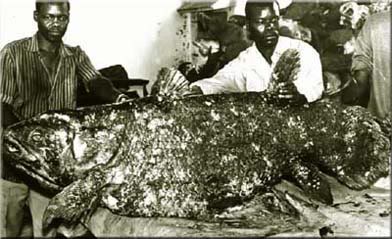Movie Science Notebook: Living Fossil on the Campus!
 At left is specimen of coelacanth as depicted in the Universal International 1958 lab-coats-'n-cavemen romp Monster on the Campus. Prof. Blake (Arthur Franz) of Dunsfield University is excited to acquire his own dead coelacanth, which arrives packed in a box and bleeding freely into the shallow water which serves as its only packing. The coelacanth is able to survive the long trip from Madagascar because the it has been "treated with gamma rays." We are not told how the back of Troy Donahue's truck smelled after gallons of giant fish-goop sloshed around in all afternoon.
At left is specimen of coelacanth as depicted in the Universal International 1958 lab-coats-'n-cavemen romp Monster on the Campus. Prof. Blake (Arthur Franz) of Dunsfield University is excited to acquire his own dead coelacanth, which arrives packed in a box and bleeding freely into the shallow water which serves as its only packing. The coelacanth is able to survive the long trip from Madagascar because the it has been "treated with gamma rays." We are not told how the back of Troy Donahue's truck smelled after gallons of giant fish-goop sloshed around in all afternoon.
 Here is a real example of Latimeria chalumnae, the coelacanth. Once believed by white people to be exctinct for 70 million years, in 1938 a live coelacanth was found off the coast of South Africa. This ancient order of the oldest lineage of jawed fishes has survived since the Middle Devonian period, some 410 million years ago. They are not quite as "untouched" by evolution as Prof. Blake would tell his friends, for they have evolved to give birth to live, adorable babies.
Here is a real example of Latimeria chalumnae, the coelacanth. Once believed by white people to be exctinct for 70 million years, in 1938 a live coelacanth was found off the coast of South Africa. This ancient order of the oldest lineage of jawed fishes has survived since the Middle Devonian period, some 410 million years ago. They are not quite as "untouched" by evolution as Prof. Blake would tell his friends, for they have evolved to give birth to live, adorable babies.
Overall, Monster on the Campus' coelacanth looks very much like his real African relatives. Prof. Blake is fixated on evolution, and the coelie is probably a cousin of eusthenopteron, the much-cuter fish that first crawled out of the sea! Blake tells us about Old Fourlegs' famous bone-reenforced fins, which it "uses to walk along the ocean floor". He does not address that the head is much bigger, with a longer snout, bulging eyes, prominent fangs and bigger lips, as if someone resculpted it to look like a dragon. Also it has spikes coming out of its face. If Prof. Blake's world were in color, we could see that the coelacanth is a deep, pretty blue.

Unfortunately these startling discoveries about gamma rays, coelacanths, and Prof. Blake's previously unheard-of definition of the word "evolution" did not leave the D.U. campus that fateful semester.
Learn about it without reading a book... just like Prof. Blake!:
-PBS NOVA coelacanth site includes a clickable fish anatomy-lesson and a neat summary of Marjorie Courtenay-Latimer's 1938 discovery!
-DINOFISH.com is the coolest and scariest coelacanth site!


No comments:
Post a Comment